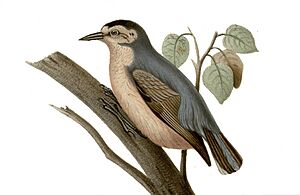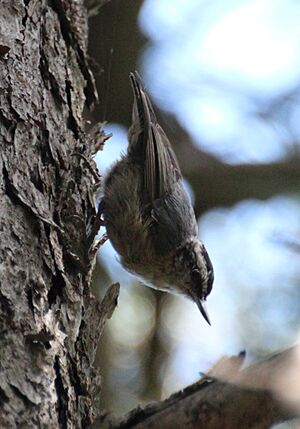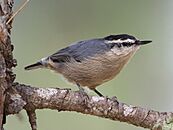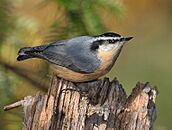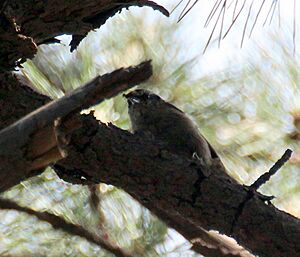Chinese nuthatch facts for kids
Quick facts for kids Chinese nuthatch |
|
|---|---|
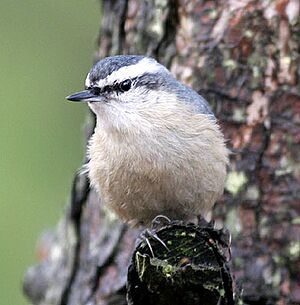 |
|
| In Korea | |
| Conservation status | |
| Scientific classification | |
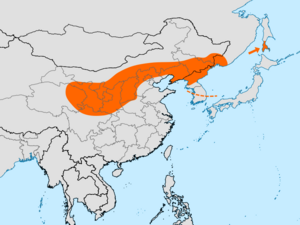 |
|
| Range of the Chinese nuthatch | |
| Synonyms | |
|
The Chinese nuthatch (Sitta villosa), also called the snowy-browed nuthatch, is a small bird from the Sittidae family. It measures about 11.5 centimeters (4.5 inches) long. This bird has blue-gray feathers on its back and a dull, buff-gray to cinnamon-orange color on its belly. Its cheeks are white.
Chinese nuthatches have a special look that helps tell males and females apart. Males have a very black head, while females have a blue-gray head, similar to their back. Both sexes have a dark gray stripe across their eyes, with a clear white stripe above it. Their song is made of repeated, small whistles. These birds mostly eat insects in summer, but they also enjoy seeds and fruits. They usually build their nests in holes found in conifer trees. Each pair raises one group of five or six chicks every year.
You can find the Chinese nuthatch in central and northeast China, as well as in Korea and the far southeast of Russia. There are three slightly different types, or subspecies, of this bird: S. v. villosa, S. v. bangsi, and S. v. corea. Scientists believe the Chinese nuthatch is related to the Corsican nuthatch and the red-breasted nuthatch. Because there are many Chinese nuthatches and their numbers seem stable, the International Union for Conservation of Nature says they are a species of "least concern", meaning they are not currently in danger.
Contents
About the Chinese Nuthatch
Naming and Types
The Chinese nuthatch was first described in 1865 by a French bird expert named Jules Verreaux. He studied birds sent to him from Beijing, China. Verreaux noticed that this bird had long, soft feathers, so he named it "villosa," which means "hairy" in Latin.
There are three main types, or subspecies, of the Chinese nuthatch:
- Sitta villosa villosa (Verreaux, 1865): This is the original type. It lives in southeast Siberia, north-central and northeast China, and Korea.
- Sitta villosa bangsi (Stresemann, 1929): This type was described in 1929 and is found in central China.
- Sitta villosa corea (Ogilvie-Grant, 1906): This type lives on the Korean peninsula and in southeast Siberia.
Family Tree of Nuthatches
Scientists study the DNA of birds to understand how different species are related. In 1998, a scientist named Eric Pasquet looked at the DNA of several nuthatch species. He found that the Chinese nuthatch is closely related to the Corsican nuthatch and the red-breasted nuthatch. These three species are like close cousins.
Later, in 2014, more research confirmed these relationships. It showed that the Yunnan nuthatch is also part of this group, but it's the most ancient relative.
|
Where They Came From
Scientists believe that the ancestors of these nuthatches spread out over millions of years. About five million years ago, one group of nuthatches moved into the Mediterranean area, leading to species like Krüper's and Algerian nuthatches. Another group stayed in Asia, and some of them later moved east, becoming the red-breasted nuthatch. About one million years ago, the Chinese and Corsican nuthatches separated, with the Corsican nuthatch ending up on the island of Corsica.
What They Look Like
Feathers and Size
The Chinese nuthatch is a small bird, about 11.5 centimeters (4.5 inches) long. Its back is blue-gray, and its head can be shiny black or dark gray. Its belly ranges from a dull buff-gray to a bright cinnamon-orange. The exact colors can change slightly depending on if it's a male or female, how old its feathers are, and which subspecies it belongs to.
This bird has a clear white stripe above its eye and a dark stripe across its eye. Its beak is thin and pointed, like a needle. The beak is slate-black, and its eyes are brown. Its legs and toes are dull blue-gray.
Males and females look different. Males have a very black head and a clear black eye stripe. Females have a head that is only slightly darker than their back, and their eye stripe is less clear. Young males have a blacker head than young females, but not as black as adult males.
Similar Birds
The Chinese nuthatch can sometimes be found in the same areas as the Eurasian nuthatch. However, the Chinese nuthatch is smaller, has a clear white stripe above its eye, and males have a black head. Its belly is also plainer.
It can also be found near Przevalski's nuthatch. Both have bright cinnamon-colored bellies. But the Chinese nuthatch has a black eye stripe, while Przevalski's nuthatch has very light cheeks.
The Chinese nuthatch is very similar to the Corsican nuthatch, but the Corsican nuthatch only lives on the island of Corsica and usually has less bright colors on its belly. Both are also related to the red-breasted nuthatch, which has even brighter colors and a more noticeable eye stripe.
- Similar or related nuthatch species
-
Corsican nuthatch (S. whiteheadi)
Life and Habits
Sounds They Make
The Chinese nuthatch often sings from the tops of pine and spruce trees. They make a few different types of sounds:
- A harsh, long schraa call, like a Eurasian Jay. They make this sound when they are excited.
- Quiet, short, and melodic calls like whip, whip whip... or quip-quip-quip. Their song is made of many of these calls, getting louder as they sing.
- Fast, rising whistles, like tsi-pui-pui-pui-pui....
- A flat, less musical rattle, like duiduiduidui....
- Short, nasal notes, quir, quir, often in long, fast series.
What They Eat
In summer, the Chinese nuthatch eats almost only insects. Young birds also eat only insects. Studies show that from April to August, about 98.5% of their diet is insects, including beetles, bees, wasps, butterflies, and flies. They hold larger insects with their feet and tear them apart with their beak. They can even catch insects while flying!
Like other nuthatches, they store food for later. In winter, their diet changes to mostly nuts, seeds, and tree fruits. In winter, they often join groups of different bird species to look for food.
Raising Young
In the Jilin region, the breeding season for Chinese nuthatches is from late April to early May. They usually build their nests high up in holes in conifer trees, often more than 9 meters (30 feet) above the ground. Sometimes, they might nest in a rotten tree stump or an old building.
Both the male and female work together to build the nest in about seven to eight days. They make a cup-shaped nest from plant fibers, feathers, and grasses. The female lays between four and nine eggs, but usually five or six. The eggs are white with reddish-brown spots.
The female sits on the eggs to keep them warm, while the male brings her food. The chicks hatch after 15–17 days. Both parents help feed the young birds. Chinese nuthatches usually raise only one group of chicks each year.
Tiny Hitchhikers
In 2011, a tiny feather mite called Pteroherpus surmachi was discovered living on the Chinese nuthatch.
Where They Live
The Chinese nuthatch lives in northeast China, Korea, and the far southeast of Russia. They have been seen on the Russian island of Sakhalin, but they might just be visiting there.
In China, they are found in many areas, from eastern Qinghai to parts of Gansu, Shaanxi, Shanxi, Liaoning, Hebei, Beijing, and Sichuan. In Korea, they are found in the north, and sometimes visit South Korea in winter. They especially like forests with Japanese Red Pine trees in Korea. In China, they live in coniferous forests (like pine and spruce), sometimes mixed with oak and birch trees.
In 2006, some scientists thought they saw Chinese nuthatches nesting in the Altai Mountains, far from their usual home. This area is where China, Kazakhstan, Mongolia, and Russia meet. They saw birds that looked like Chinese nuthatches, with black heads on the males and white stripes above their eyes. However, later research in 2017 suggested that these birds were likely a local type of Eurasian nuthatch that might have had unusual feathers. Scientists continue to study these sightings to be sure.
Their Status and Dangers
The area where the Chinese nuthatch lives is very large, about 1.81 million square kilometers (700,000 square miles). We don't know the exact number of these birds, but they are not considered rare in China. In Korea, fewer than 1,000 are thought to migrate.
Even though their numbers might be going down because of forest loss, the International Union for Conservation of Nature lists the Chinese nuthatch as a species of "least concern". This means they are not currently in danger of disappearing.
However, a study in 2009 looked at how climate change might affect nuthatches. It suggested that the area where the Chinese nuthatch lives could shrink by a lot (about 79.8–80.4%) between 2040 and 2069. This shows that climate change could be a future threat to these birds.
Images for kids



